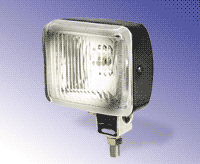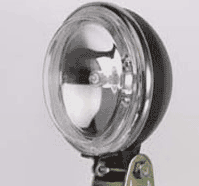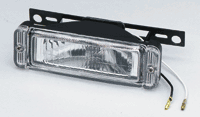Headlights
The
headlight(s) are a) one or two 12 volt, 14W or 25W quartz-halogen sealed beam(s) or
b) automotive
driving
light(s) with the stock high wattage MR11 or MR16 lamp(s) changed to a lower wattages. It is
also possible to use an an automotive driving light with an H3 bulb.
MR11 and MR16 based housings will always be metal because of heat issues
(plastic is a thermal insulator and will not conduct the heat away from the
small lamp).
Dual headlights make sense for several reasons.
First, on a single ride, you may be riding part of the time in areas where you
just need to be seen, and two headlights are unnecessary; you extend
your run time by turning off the one headlight. Second, if one headlight
burns out, you have a back-up. Third, dual headlights make your bicycle look
more like a motorcycle.
If you ride a lot on bicycle paths or shared
pedestrian/bicycle paths, then you should consider adding a very low wattage
headlamp (i.e. 5W), and an LED blinker. While a 5W lamp and LED blinker are not
suitable for road riding, they are adequate for low speed riding on
paths. You could also opt for an AA powered Mag Light for use on bike paths. It
is inconsiderate to use high power lights on bicycle paths, and since there are
no motor vehicles, "being seen" is less of an issue.
|
MR16 Lamp History
The MR16 lamp was introduced
by General Electric in 1975. It was developed in response to a need for a
compact
low voltage light source with precise optical control. MR stands for
"Mirrored Reflector."
At the time, the intended use was for overhead
projectors and microfiche readers. However it was soon adopted for use in
a myriad of other applications. This was because of the combination of
small size, precisely controlled beam, and quality of light. Today you
find the MR16 in automotive and bicycle lighting, display lighting, and
interior lighting, MR16 bulbs are available in a huge number of beam
patterns, color temperatures, and voltages, as well as being available
with and without front cover glass. MR16 lamps have become the lamp of
choice in all high end bicycle lighting systems. |
Sealed Beam
I find a sealed beam is less troublesome
than a housing with a removable lamp and the larger reflector produces more
light per watt than an MR11 lamp, though in a less focused pattern. The 14W beam is
actually perfect for bicycle commuting at speeds up to 20 mph; it both lights
the road and makes you very visible. The
sealed beams make the bicycle look more like a motorcycle than do the tiny MR11
lamps. The beam is used without a housing, and is very
lightweight (less than an MR11 or MR16 lamp inside a metal housing). It runs cooler than the MR11 and MR16 type of lamps, and it is
waterproof. However the sealed
beams are not as cool looking (I think that they're retro looking) as those tiny housings used by commercial
systems, and the beam is not easily aimable once installed.
Use 8/32" screws
(length depends on what you are mounting it to) through the terminal holes after
you tap threads with the short self-tapping screws that are included. Use ring
lugs for a #8 stud on these bolts to bring power to the headlight. The set-up does
look rather geeky due to the wooden plank. Painting the plank black, or covering it with
black heat shrink tubing, would degeekify it quite a bit (in my opinion). A
system that an engineer can love! My six year old son was very impressed with
it. Kids that I pass while riding think that the lights are way cool.
The 14W beam is Intermatic/Malibu LV504, the 25
watt beam is LV505. The LV505 is sold only at Home Depot (I have not seen it
on-line or at other hardware stores).
|
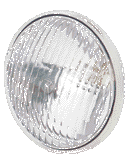 |
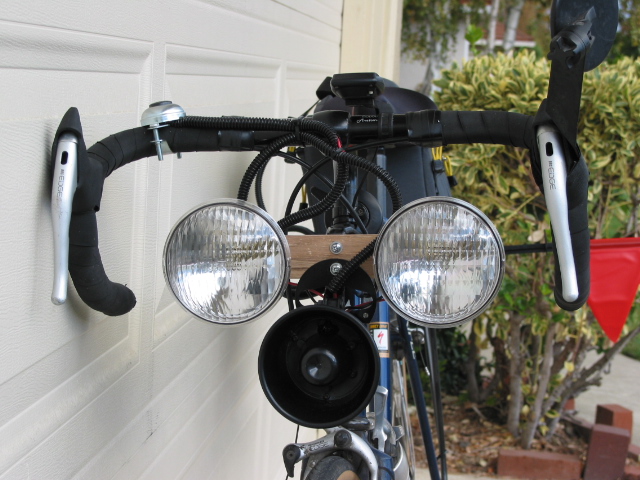 |
|
Quartz-Halogen Sealed
Beam
LV504=14W, LV505=25W
$7
|
My road bike/commuting bike with
dual 14W quartz-halogen sealed beams mounted on solid oak and attached to the reflector bracket.
No handlebar clutter! 25 watt quartz- halogen sealed beams are also available,
but avoid the 11 watt non-halogen sealed beam. I2 volt horn is between
the two headlights. |
MR11
Lamp Based Headlamps
Most commercial bicycle lighting
systems use MR11 halogen lamps. While these lamps are easy to find, it has been
a problem finding the proper enclosure. Try to avoid using PVC pipe, tow ball
covers, etc. for a housing. These are tacky, do not dissipate heat well, are not
aimable, and the mounting to the bicycle is difficult. I did find two different inexpensive
driving lights that use the MR11 lamps (thanks to an e-mailer for pointing out
the availability of the Eagle Eye Driving/Fog lights).
The problem with MR11 based
headlamps is that the reflector is really too small to be efficient enough with
lower wattage bulbs. Thus, the MR16 based headlamps are a better choice in terms
of lumens/watt.
Click
Images for Details
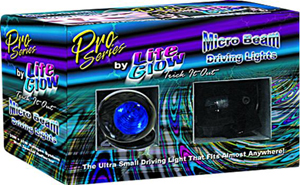 |

|
Micro Beam (get the ones with
clear lenses)
Comes with 35 watt lamps. MR11 lamps with covers are used, there is no
lens build into the fixture. |
Eagle Eye
Driving/Fog Lights
These are similar to the Micro Beam,
but
they come with 20 watt lamps. Choose the ones with clear lenses. A fuse
and fuse holder are included. Also available under the Rally brand, at
Pep Boys, for $30.
Not sure if lens is built into the
fixture or if an MR11 lamp with a lens is needed.
|
| $22 |
$23
$25 |
A pair of Lite Glow Micro Beam
driving lights (35W MR11 lamps) costs $22 from http://www.autobarn.net/tb3000series.html,
though I should warn you that if they are out of stock and waiting for shipment
from the manufacturer that if can take months for your order to come. Get the
ones with clear lenses.
A similar light to the Micro Beams
are the Eagle Eye Driving/Fog lights, model 1862BW. These come with 20 watt
lamps, so they may be a better choice than the 35 watt Micro Beam (you only have
to change one of the lamps to a lower wattage lamp if doing a dual lamp system).
Do a Google search for 1862BW. Two sources are: TRUCKADDONS.COM
and EarlOwen.com
(call them at 800/527-2006 and the price may be a bit cheaper).
MR16
Lamp Based Headlamps
The larger reflector of MR16 lamps means more light output for a given
wattage. This comes at the expense of a slightly larger and heavier housing. 12 volt MR16
lamps are available from 5W to 75W versions. 6 volt MR16 lamps are available in
5W and 10W versions. 5W MR16 bulbs are very hard to find, but I
did find one source in the U.K., see: http://www.e-go.gb.com/parts.asp.
MR16 (and MR11) lamps are especially
good for battery powered applications that require high efficiency because their
precise beam control increases the center beam candlepower. This is not easy to
do with assemblies where the reflector and bulb are two separate pieces.
The driving lights should be relatively waterproof, but use some
silicone sealant on the seams. I was quite surprised at the difficulty of
finding MR16 based driving lights. I think that it has to do with the fact that
with a sealed unit it is difficult to keep a 50W lamp from overheating. Most
automotive driving lights use 55 watt H3 bulbs with a big housing, big,
reflector and big glass lens, which helps to mitigate thermal issues. MR16 track
lights are ventilated, and use MR16 lamps without covers. These driving lights
are a much better method of using MR16 lamps than fabricating your own holder.
The QH-7CC is basically a metal can
with a socket and an MR16 (with cover) lamp. The cover ring removes without
tools by turning and pulling. You should use some silicone sealant around the
ring so it doesn't vibrate off, and seal the back where the wires come out.
The Eagle Eye 1874C is a very
interesting fixture since it allows two lamps in one fixture, just as some of
the higher end commercial bicycle lighting fixtures. However there is actually a
big disadvantage in using a dual lamp fixture because each lamp cannot be aimed
separately. With two separate lamps you can aim one straight ahead to illuminate
the road far ahead of you, and one slightly down to illuminate the road surface
right in front of you.
Click
Images for Details
|
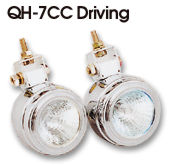 |
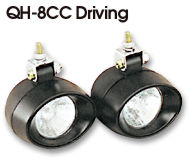
|
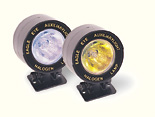
|

|
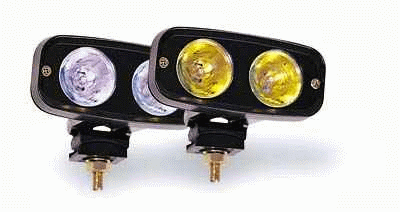
|
| Optronics QH-7CC
MR16 driving lights (set of two). Comes with 50W lamps which you can
change to a lower wattage. I
read one review of these that suggested some silicone sealant around the
seams, and I agree with this recommendation. One of these would be very easy to mount to a reflector bracket.
You can change lamps without tools. These
fixtures do not have lenses so you must us lamps with covers.
Ignore
the JC Whitney catalog blurb that says that these are H3 bulbs, they are
MR16 bulbs. Also ignore the on-line description which states that these
have yellow lenses, they have clear lenses, as stated in the paper
catalog.
|
Optronics QH-8CC MR16 driving
lights. Comes with 50W lamps which you can change to a lower wattage. One of these would be very easy to mount to a reflector bracket.
I
have not found these for sale anywhere. JC Whitney sells the version
with yellow fog-light lenses.
|
Eagle
Eye 1866C; 50W MR16 lamps.
Apparently discontinued. |
Eagle Eye 1873C; 50W MR16
lamps
Get
the clear version (C suffix)
Screwdriver needed to change lamp.
Apparently discontinued. |
Eagle Eye 1874C; Dual 50W
MR16 lamps
Wow, this is the fixture I've been
looking for. Thanks to the person who e-mailed me this. With this
fixture you can have two different lamps in one fixture (high/low,
spot/flood, etc.).
Share a set of these with a friend, or
equip two bicycles with lights. A little more expensive than using two
single Optronics lamps, but less hassle to mount.
Get
the clear version (C suffix)
Screwdriver needed to change lamp.
Apparently discontinued. |
|
$19.99 |
Unavailable
|
Unavailable
|
Unavailable
|
Unavailable
|
H3 Headlamps
There are many automotive driving
lights that use H3 type halogen bulbs. These driving lights are available
with rectangular reflectors and lenses which are better than the small round
MR11 type lamps. The problem with H3 based headlamps is the lack of any H3 bulbs
lower than 25W. The lowest wattage 12V H3 bulb is 35W. The lowest wattage 6V H3
bulb is 25W (very hard to find, but I did locate one source for it). If you go this route then be sure to use switches and connectors
that are rated at 6 amps. You'll want to use 7500mAH NiMH D cells or a 6V sealed
lead acid battery. One advantage of the H3 fixtures are that they typically have
better lenses and reflectors than the MR11 and MR16 lamps. One disadvantage is
that they typically have thick, heavy, glass lenses because the lenses are
designed to be more resistant to breakage.
Click
Images for Details
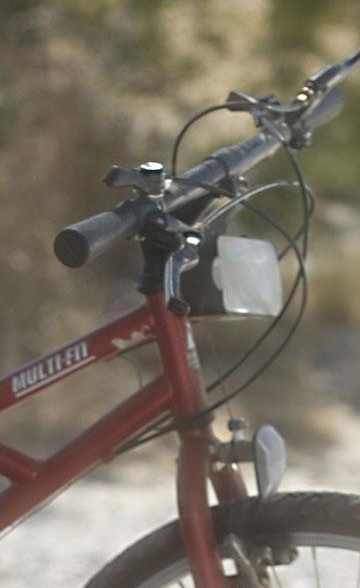 |

|
|
I met this woman riding nude
in Marin county (her not me). She was riding a hybrid bicycle on a
mountain bike trail not the easiest thing to do. I was hiking with my
digital SLR, wearing a photographers vest, with the camera mounted on a
hiking stick/monopod. She thought that I was a professional photographer
and insisted that I photograph her. I was intrigued by this large
headlight on her bicycle which appears to have no power source, so there
must be internal batteries. It looks like an automotive driving light. I
could not find this light anywhere on the web. This was near Muir Beach
which is close to Muir Woods, which is a popular nude beach. I've often
run into nude hikers and cyclists on these trails, though technically
bicycles were not allowed on this particular trail. Yeah, I know, how
come I was so interested in the bicycle light? |
Low Wattage
MR11 and MR16 Lamps
Since the lamps that come with
the MR11 and MR16 based driving lights may be too high of a wattage for a battery powered
light, you will want to replace the included lamp with a a lower wattage lamp. Check
to see if the housings have their own lens and use lamps without covers, or if
they require a lamp with an integral cover. MR16 lamps are a much better choice
than MR11 lamps, due to their much higher lumens/watt efficiency.
MR11
There are 12 volt MR11 lamps available at 5W, 10W, and 20W. There are also 6 volt
MR11
lamps available if you want to build a 6 volt system, but you don't get as big
of a choice in lamp types.
MR11 lamps come in different types
with regards to the type of beam they project:
ANSI
Code |
Beam
Description |
Beam
Angle
(Degrees) |
| FTA |
Narrow Spot |
9.5 |
| FTB |
Spot |
10 |
| FTC |
Narrow Flood |
17 |
| FTD |
Wide Flood |
27 |
| FTE |
Spot |
12 |
| FTF |
Narrow Flood |
18 |
| FTH |
Wide Flood |
38 |
Lamps can come with or without cover
glass. If your fixtures already have a glass lens then you don't need the lens,
and in fact the lamp will probably not fit in the fixture with the lens on there
(you can probably pry it off, especially if you heat it first). There will be a C
or L or FG suffix to indicate a cover or lens or front glass. The description
will always mention a lens or cover if the lamp has a cover.
The lower wattage lamps generally do
not specify a beam angle as the light is too weak to matter. 5W and 10W lamps
are more for being seen and staying legal than being able to actually see
anything. Starting with 20W lamps you get a wider choice in beam angles. Try to
get an FTD or FTH lamp (27 or 38 degrees) for your 20W main headlamp. Ikea sells
the 38 degree 20 watt lamp (and the 10 watt 38 degree lamp) for $2 each. Got
that? $2. Night-Sun charges $20 for a replacement MR11 12 volt flood lamp (1000%
more). And at Ikea you can eat lunch really cheap too!
The more common the lamp, the
cheaper they are. For example the 12 volt 20W or 10W wide flood lamps with cover cost
as little as $2 at Ikea, but even mail order you can get the 20W for $2.45. The lower wattage
lamps are more of a specialty item and cost more,
i.e. the 5W lamp costs $5.60. It is outrageous what the commercial bicycle
lighting companies charge for replacement lamps. For example, Night Sun charges
$20 for 20W flood lamp that you can purchase for $2 at Ikea..
See lamp specs at: http://www.bright.co.jp/english/prd/hal_01.html
Sources
Ikea
Ikea stores sell the 12V MR11 FTH/G
wide flood for $2 in 10W and 20W versions. Not available on-line. Unfortunately,
none of their fixtures for MR11 lamps are suitable for bicycle lights.
http://www.atlantalightbulbs.com
6 volt lamps
5W 6V MR11 G4
10W 6V MR11 G4
12 volt lamps
5W 12V MR11 G4
20W 12V MR11 FTD/L
DG
Lighting Supplies , good prices. 12
volt only, 20W and 35W.
United
Halogen Bulb sells 5W,10W, 20W, and 35W lamps in both 12 volt and 6 volt
varieties.
PEC
Online Lamp Store sells four types of 12V 20W
lamps
Harrington
Lights sells 5W and 10W, 6V and 12V, narrow flood lamps
MR16
MR16 lamps come in different types
with regards to the type of beam they project. For 12 volt, 20W lamps, the codes are as
follows:
ANSI
Code |
Beam
Description |
Beam
Angle
(Degrees) |
| EZX |
12 volt, 20W, Narrow Spot |
7-8 |
| ESX |
12V 20W Spot |
11-12 |
| BBF |
12 volt, 20W, Narrow Flood |
24 |
| BAB |
12 volt, 20W, Flood |
36 |
Add "/FG" to the code for a front
cover
If using the Optronics QH-7CC driving
lights then you need MR16 lamps with lenses.
In a single lamp system, I would
suggest using the ESX lamp. This is a good compromise in terms of beam angle.
In a dual lamp system, I would
suggest using one EZX and one BBF.
Sources
Harrington
Lights sells 12V 10W MR16 lamps (narrow flood), with a lens.
Harrington
Lights sells 12V 20W MR16 lamps (flood and narrow spot)
5W MR16 bulbs are very hard to find, but I
did find one source in the U.K., see: http://www.e-go.gb.com/parts.asp.
These bulbs all have lenses. These have an 18 degree beam angle, which is
halfway between spot and narrow flood. A flood pattern would be better if this
lamp is to be used as a "being seen," while a spot pattern would be better if
this lamp is to be used as a "seeing" lamp, but the 18 degree angle is a
compromise that allows this lamp to be used in a single lamp system.
Luxeon V LED
Luxeon V LEDs are very efficient,
but as of now are too expensive, and have too short of a life-span, to consider
using in bicycle lights. Like any semiconductor, heat is the problem; the high
forward current necessary for high illumination, results in a very hot operation
and a very short life,
especially because it is not practical to cool the fixture when used for a
bicycle light. Another issue is that they lack the precision optics of an MR
style mirrored-reflector/bulb.
Return to http://bicyclelighting.com









